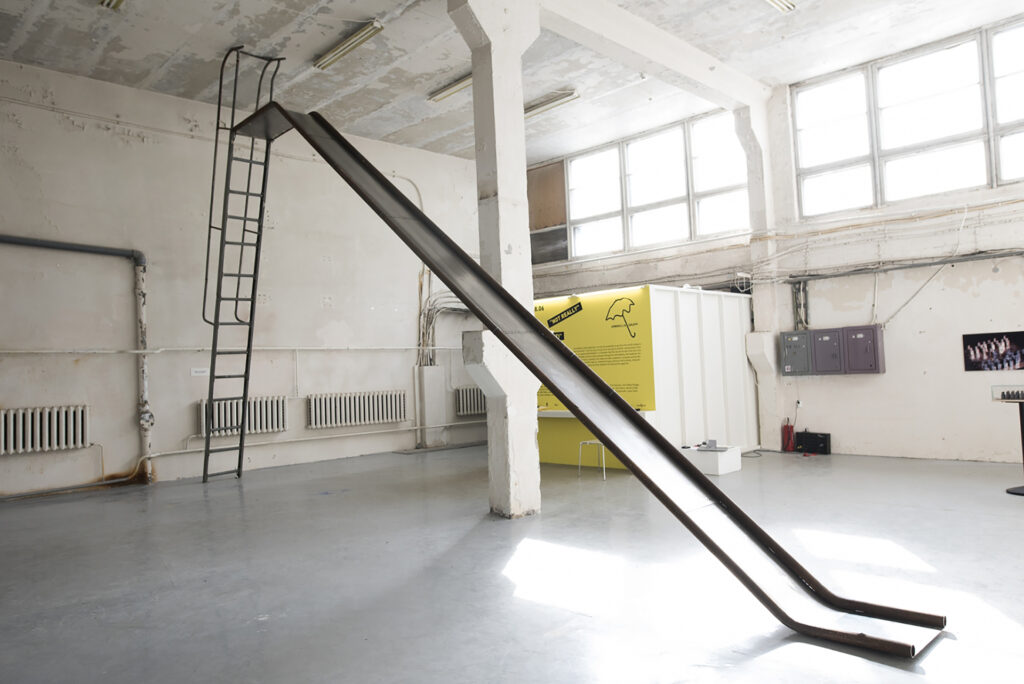
Hanna Samoson (born 1987) is an interdisciplinary artist whose work spans photography, video, installations, and performance art. Before transitioning to contemporary art, she worked as a music video director. Her practice weaves together a keen awareness of time with a touch of absurdist humour. Through intimate perspectives, Samoson explores themes of grief, identity, and the environment, revealing deeper social realities.
Previously more active in the film world, Samoson made a striking transition to contemporary art with the installation “Untitled” (2017/2019), part of her series “Mom, You Don’t Have to Worry About It”. The work features an oversized, menacing metal slide, symbolising both danger and allure. First exhibited in 2017 at the ARS Project Space, it was reinstalled in 2019 – this time cut into sections and placed between the floors of the Contemporary Art Museum of Estonia (EKKM). Despite its altered physical form, the piece retained its conceptual impact, evoking a society in self-destruction, where the human-made world turns ominously against its makers. The work stems from Samoson’s personal need to explain to her parents the seemingly irrational choices she made in her youth – situations where taking a risk seemed justified, even if it might lead to failure.
In the autumn of 2020, Hanna Samoson carried out a durational performance in which she hiked nearly 220 kilometres – twice – along the planned route of the Rail Baltica railway, from Ikla to Tallinn. The first journey, undertaken shortly after her grandmother’s death, became a personal pilgrimage of mourning: a solitary passage through grief and memory, with no option for escape. Along the way, Samoson found that the stillness and equilibrium of nature offered quiet responses to her own interpretations and unanswered questions about her grandmother’s life.
On her second hike, Samoson livestreamed the journey, and footage from the broadcast was later featured in the documentary “Trail Baltic. A Trip to the Green” (2023), directed by Marianne Kõrver. During the trek, she engaged with individuals whose lives are directly impacted by the planned railway. As the walk unfolded, fantasy and reality began to blur, transforming the journey into an encounter with the unknown – shaped both by the looming presence of the large-scale infrastructure project and the personal stories that surfaced along the route.
Recurring motifs in Hanna Samoson’s video works reveal a fluid interplay between fantasy and reality, where physicality becomes a mirror of inner states. In “Mythology of Long-Distance Running” (2021), traditional meditation is replaced by a trance-like run that gradually transforms into a dance. Along the way, dysmorphic monsters and fantastical creatures emerge, reflecting the artist’s internal journey and her effort to retain control in a stagnating world. This exploration of automatist drawing and subconscious image-making continues in the biographically infused video “Time Loser” (2022), which probes the paradoxes of creative life. The work grapples with the pressures of time, the pursuit of artistic freedom, and the unsettling notion that time itself may be an illusion. The creatures that populate the video embody impossible ideas – visual metaphors for the artist’s inner tensions and whimsical self-reflection.
The blurring of reality and fantasy continues in Samoson’s video work “2222” – a 9-minute and 50-second poetic journey inspired by a dream of a place where the human self dissolves into pure being. In the piece, Samoson traverses Estonia’s wintry landscape in search of an unknown island glimpsed in the dream – one of the country’s 2,222 islands. The result is a meditative exploration in which shifting landscapes and rhythmic movement echo an inner dialogue and the longing to cross boundaries, both physical and spiritual.
In recent years, Samoson has developed a deep interest in working with stones. She views the unshaped stone as a paradox – containing everything, and yet nothing. To her, it holds pure potential: the possibility of becoming something, even before it has actually become anything.
At the end of 2023, Hanna Samoson opened her first solo exhibition, “Magic Is Sometimes Very Close to Nothing At All”, at the Lasnamäe Pavilion of Tallinn Art Hall. The exhibition took shape during a period in her life marked by a profound sense of solitude – a feeling that perhaps she was the only one left in the world. Through a constellation of videos, installations, and stone sculptures, Samoson created a journey that unfolded both in physical space and within the viewer’s inner landscape. The pavilion became an intimate setting for reflecting on loss, transformation, and the quiet thresholds between them. For Hanna Samoson, creation is not about executing a plan, but about being willing to let go – so that something greater can emerge. Letting go is not a loss, but an opportunity to move from the physical level to a deeper one, where intuitive human perception comes to the surface.
In 2025, Hanna Samoson participated in the 9th Artishok Biennial, titled “Siesta”, with her work “How to Find the Lion That Has Swallowed You?”, a psychogeographic exploration of self. The piece comprised 144 drawings and a spatial network constructed from hemp rope and yarn. This fragmented series of images formed a kind of mind map through which the artist gave visual shape to her emotions, inner tensions, desires, and hopes. The woven network spanned the exhibition space, linking the drawings into a unified system that evoked a neural network, a spider’s web, and the imaginative worlds of childhood play. As in much of Samoson’s practice, the work seamlessly merged the personal with the universal – touching on themes of wandering, misunderstanding, and, ultimately, acceptance and the possibility of new beginnings.
Hanna Samoson has studied audiovisual media at the Baltic Film and Media School, and photographic art at the Estonian Academy of Arts, where she earned a BA in Photography, as well as at the FAMU Film and Television School in Prague, where she completed an MA in Photography. In 2024, she received the annual award from the Visual and Applied Arts Endowment of the Cultural Endowment of Estonia.